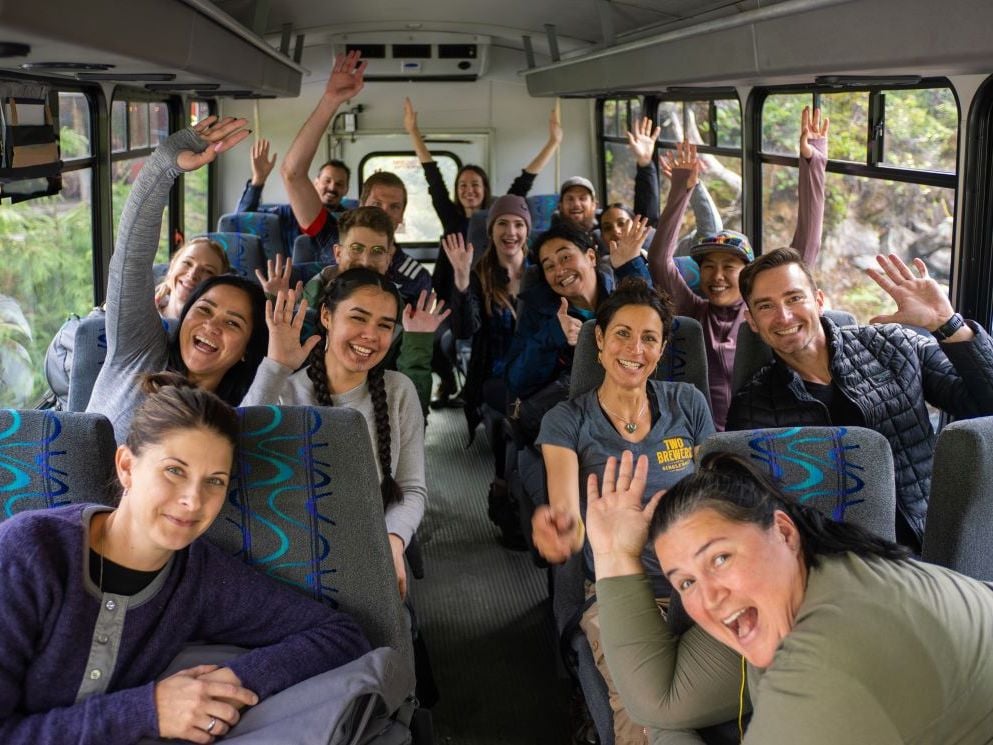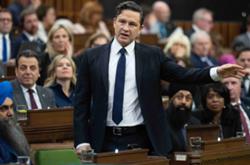Jessica Hum and a dozen other Vancouver Island University students boarded a bus in late September 2022 on a journey to the cabin of master canoe carver Elder Joe Martin, tucked away in the thick forests of Tla-o-qui-aht Tribal Parks near Tofino. The students were about to begin an immersive, five-day field school as part of the newly formed Indigenous Protected and Conserved Areas planning certificate program at VIU — the first of its kind in Canada.
Tla-o-qui-aht Tribal Parks is in the unceded territory of the Nuu-chah-nulth peoples and has been cultivated since time immemorial, making it a fitting outdoor classroom for a program that braids together western education and Indigenous knowledge systems.
Hum, a third-generation Chinese and Ojibwe woman, saw stands of cedars in Tla-o-qui-aht Tribal Parks and was reminded of the lone, massive cedar that grew in front of her childhood home on a bustling street in downtown Toronto. Her father planted the tree in the 1950s, and it eventually grew to offer the comforts of nature among the backdrop of a busy city.
“It was this tree where my brother and I could play,” Hum told The Tyee. “We could go into the tree and be hidden by all of the foliage and watch what was going on and listen, but kind of be an observer of the street.”
Now Hum and her fellow students were about to learn how to observe and care for coastal zones where cedar trees have many jobs, including providing healthy nutrients for the ecosystem and supplying materials for items such as canoes, totems and clothing.

The curriculum of the yearlong program at VIU was developed by IISAAK OLAM, an Indigenous-led not-for-profit that is dedicated to building capacity for Indigenous Protected and Conserved Areas, or IPCAs.
Monica Shore, co-founder and executive director of IISAAK OLAM and an instructor for the IPCA certificate program, says it was created to address the need for more planners to adequately and appropriately support Indigenous-led conservation such as IPCAs, which are required for Canada to meet its ambitious conservation targets.
Most of the six courses are offered in a part-time online format, making it accessible for students across the country to participate. The program is taught by a mix of VIU instructors, who facilitate discussions, and Indigenous knowledge keepers, who share traditional knowledge about land-based teachings and Indigenous-led conservation.
“Graduates from the program will be equipped to support the planning of IPCAs in their communities and nations, to guide partners from various sectors who are seeking ways to be better allies, or to take on new roles within their existing organizations with a focus on Indigenous-led conservation,” Shore said.
“They will have a much deeper understanding of the key concepts and approaches required to plan for conservation through a reconciliation lens and can even play a meaningful role in lobbying for conservation policy that respects the original stewards of these lands and waters.”
The knowledge gained in the program will also empower graduates to follow the recommendations laid out in "We Rise Together," a report on IPCA research and recommendations published in 2018 by the Indigenous Circle of Experts.
According to the report, conventional protected areas have historically displaced Indigenous Peoples from their own territories by force, gravely affecting communities culturally, economically and spiritually.
Conventional protected areas were also commonly based on the ideology that humans should be removed from the environment in order to protect nature — a misconception known as the “pristine wilderness myth” that once ruled the West’s idea of conservation and caused generations of harm.
Shore says that while conventional protected areas have traditionally focused on excluding human access, Indigenous-led conservation planning views humans and nature as intertwined. Vancouver Island University’s IPCA program approaches protected areas with Indigenous teachings that weave humans, animals and ecosystems together to plan for the future.
The program teaches planning on a much longer time scale than traditionally seen with western land use plans — measured by not just a few decades, but rather the next 500 years.
“With 500 years, it positions you to that kind of thought process... thinking not about yourself on what you want to see when you're sitting in a rocking chair, but rather, what you'll leave behind for the world,” said Shore.

Indigenous-protected areas are being declared all across Canada, bringing forward the long-term thinking that has been absent in Canadian conservation. For land to be considered an IPCA, it must be Indigenous-led and declared as such by the Indigenous nation. Some examples include Gwaii Haanas, declared by the Haida in 1985, and Gitdisdzu Lugyeks (Kitasu Bay), declared by the Kitasoo Xai’xais Nation in 2022.
There are many reasons for declaring an IPCA, including to protect land from unwanted development, to reaffirm control over the type of development and industry in a territory and even to designate a traditional territory as a place of healing.
One of the IPCA program’s assignments required students to bring something meaningful from home for the field school. Hum reflected on her memories of playing with her brother in the cedar that grew in front of her childhood home — a tree of life thriving amidst the urban concrete landscape. In honour of this memory, she decided to use cedar clippings to make a rubbing. To record impressions of textures from plants and other materials, ethnobotanists and artists place paper on top of the subject and rub it with something that will leave a mark, such as charcoal, crayons or paint.
Later, the students were instructed to journal about the teachings they were learning in the program. When they arrived at Joe Martin’s cabin, Hum saw the remnants of a large cedar stump that the master carver had left after downing the tree to make a canoe.
“Once he's taken what he needs — for a canoe in this case — he leaves the rest of the plant and the tree there to support the growth of new cedar and other plants,” said Hum.
The practice of taking just what’s needed and giving back to the land is a form of reciprocity that students learn about in the IPCA certificate program.
Hum decided to use the stump to make a rubbing, gently recording the swirling growth rings of the cedar. Hum was struck by how many years it must have taken for the tree to grow that large.
“In many contemporary planning practices, a few decades are considered a long planning timeline. Whereas 500 years may be a single generation of cedar tree and is more akin to the long time horizon used in planning for Tla-o-qui-aht Tribal Parks,” Hum wrote in her journal of the cedar stump rubbing.
While Indigenous-led conservation and protected areas focus on relationships with the land and reciprocity, conventional land use often focuses on development or economic opportunity, even when Indigenous communities oppose it. Tla-o-qui-aht Tribal Parks has been the subject of such disputes. Joe Martin and his cabin were pillars in the resistance to old-growth clear cutting in the 1980s.
According to the "We Rise Together" report, two-eyed seeing is an approach that teaches people to view the world through both an Indigenous and a western lens, to use both ways of being to achieve greater outcomes for all. However, if people are unable to see legitimacy in both perspectives, attempting to work together can be harmful and challenging.
To reduce harm, the IPCA program and others involved in Indigenous-led conservation embrace a concept known as “ethical space.” In ethical space, people of all cultural backgrounds ensure both western science and Indigenous traditional knowledge are upheld and equally valued and respected.
“We need to re-centre and find this ethical space. It's the core value of the program,” said Shore.
“If the federal government adopted ethical space as a guiding principle for the development of conservation policy frameworks, it would ensure that Indigenous voices and perspectives help shape the way the country’s lands, waters and ice are stewarded,” continued Shore. “This is key for how Canada lives up to its original treaty responsibilities, which are living, breathing, constitutional agreements.”
Although IPCAs are led by Indigenous governments and nations, there are layers of colonial law that require Indigenous governments to engage with Crown governments and other private sector stakeholders. Shore says there are benefits to an ethical space approach in these instances as well.
“An ethical space approach to IPCA establishment fosters an openness to all world views, welcomes the best of Indigenous knowledge and western science, and supports a paradigm shift and a re-centring of Indigenous knowledge. It recalibrates the imbalance in world views from one where western science dominates to one where both have space and influence,” said Shore.

Allyson Menzies, a Métis wildlife biologist and an instructor at the Vancouver Island University IPCA program, is especially interested in Indigenous self-determination and decision-making in wildlife biology and conservation. For Menzies, ethical space is a practice that is useful in her work as a biologist.
“It's a framework that helps me think about the mental space that we have to be in in order to work across knowledge systems and work well together. It's this commitment to action and to respect values,” Menzies said.
“Everyone enters these spaces very differently. And if you're used to being someone in a position of power or privilege, you may not have had to reflect on how you enter a space. So I think it's important, in terms of a tool for reflection.”
Menzies says these frameworks can be useful when working across cultures because concepts like respect, reciprocity and conflict resolution can vary between communities.
Though the university’s IPCA program is a step in the right direction toward decolonization and new forms of education, Menzies says there is still much more to be done, especially in confronting the climate crisis.
“I think it really will take a lot of change and a shift in where we rank the importance of the environment in our everyday lives. And I don't think that'll happen without a major change or transformation,” said Menzies.
The program is technically listed as an advanced certificate with academic prerequisites, though Shore says applications from a diversity of backgrounds will be considered, and lived experiences will be considered alongside academic experience.
“Everybody comes with some experience that often is not attributed to the piece of paper they carry that says what degree they have,” said Shore.
The program offers 22 seats each year. Vancouver Island University is currently accepting applicants, and the next cohort will run in September 2024. Prospective students can apply on the VIU website.
Reporting for this article was funded by the Institute for Journalism & Natural Resources and the Gordon and Betty Moore Foundation. The Tyee maintains editorial control. ![]()
Read more: Indigenous, Education, Environment

















Tyee Commenting Guidelines
Comments that violate guidelines risk being deleted, and violations may result in a temporary or permanent user ban. Maintain the spirit of good conversation to stay in the discussion and be patient with moderators. Comments are reviewed regularly but not in real time.
Do:
Do not: